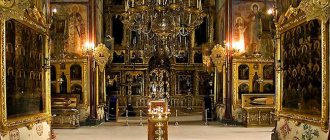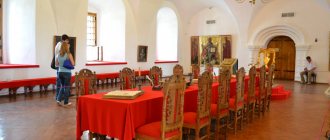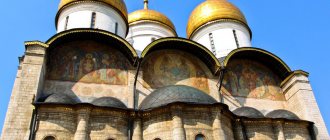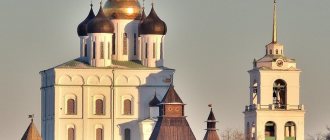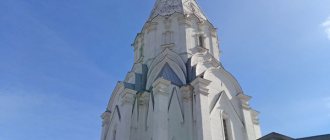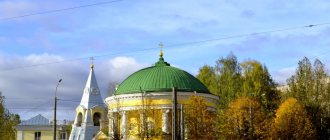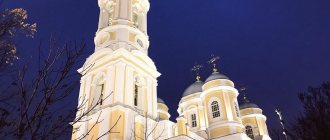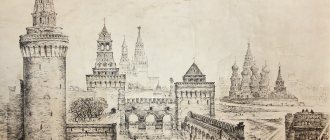The Archangel Cathedral of the Moscow Kremlin is an Orthodox church, a majestic monument of history and architecture, rising on Cathedral Square of the Kremlin Museum-Reserve.
The surviving cathedral of the early 16th century is located on the site of a wooden Moscow cathedral, also dedicated to St. Archangel Michael, from the mid-13th century and the stone church that replaced it from 1333.
The architect of the Archangel Cathedral of the Kremlin in Moscow is an Italian architect, known in Rus' as Aleviz the New. Construction of the temple took place from 1505 to 1508.
History of the Archangel Cathedral
On the site of the Archangel Cathedral, back in 1247–1248, during the time of Mikhail Yaroslavich, brother of Holy Prince Alexander Nevsky, a wooden church was built in the name of Archangel Michael. Under Ivan Kalita in 1333, a new white stone temple was built. According to one version, it was built as a token of gratitude for saving Rus' from famine due to a poor rye harvest that summer. According to another version - in memory of the deliverance of Rus' from the plague. The temple had a height of 20 meters and was the largest in the Kremlin. Ivan Kalita became the first to be buried under the arches of the temple under construction. Since then, the temple has become the tomb of the great princes of Moscow and their closest relatives - appanage princes.
In September 1933, the temple was consecrated. By the beginning of the 16th century, the church had fallen into disrepair. Then, under the leadership of the Italian architect Aleviz the New in 1505–1508. A new one is being built on the site of the old temple. To commemorate princes and kings, there were ministers performing funeral services. The building has been restored several times. In the 18th century, work was carried out twice because the temple was in disrepair. In 1772, according to Bazhenov’s design, the Southern extension was built to strengthen the building. Like other churches, after the Patriotic War of 1812 the building had to be restored. The frames and decorations from the icons were stolen by French soldiers. The icons of the first two tiers of the iconostasis were used as benches and beds. After the war, the decoration of the temple and the iconostasis were updated. The carved royal gates were made. Since 1955, a museum has been operating in the temple building. In the early 1980s, another restoration of the temple was completed. The stone tombstones and iconostasis, external and internal decoration were repaired. At the beginning of the 19th century, after the demolition of the Church of the Nativity of John the Baptist, the chapel of the holy martyr Huar was moved to the northern side of the temple.
Temple in the 19th-20th centuries
During the Patriotic War of 1812, the cathedral was destroyed by the French. But after the expulsion of Napoleon's army it was restored. The re-consecration was carried out by Archbishop Augustine in 1813. In 1826, near the wall on the south side of the cathedral, in place of the one-story one, a two-story extension-chamber was built for the church servants. The main dome was covered with copper sheets and gilding in 1837. The corner ones were painted with tinplate, the crosses on them were covered with brass and gilded.
In 1853, reconstruction and cleaning of the icons and wall paintings of the temple were carried out. Supervised the work. N. Podklyuchnikov also restored the image in the 1870s. In 1895, the cathedral was transferred to the Moscow palace office. After two years, the iconostasis was restored by Ya. E. Epanechnikov with his workshop. The work was supervised by the Moscow Archaeological Society. The Holy Synod completely transferred the Archangel Michael Cathedral to the Court Department in 1895.
For the 300th anniversary of the royal house of the Romanovs in the Arkhangelsk Kremlin, the Royal Gates, iconostasis, wall paintings were renewed, and the tomb was restored. They also made a cover with two lamps over the burial of Mikhail Fedorovich, the first tsar of the Romanov dynasty. The sketch of the canopy was made by Prince Pyotr Nikolaevich. On May 24, 1913, the lamps were lit by Emperor Nicholas II.
During the Revolution of 1917, a shell hit the wall on the south side of the temple, making, according to witnesses at the time, a hole in the brickwork. The cathedral was closed along with other Kremlin churches. But restoration work has begun. Employees of the restoration center strengthened the frames of local and major large icons, and covered the images with linseed oil.
Holiday and local faces were updated in 1934-1935. They were also strengthened and the ground and paint layers were restored. In the middle of the 20th century, a mural from the 17th century was discovered under late painting. The cathedral became a museum in 1955.
In 1960, the Kremlin Museum was assigned to the Ministry of Culture. From 1962 to 1965, archaeological and architectural work was carried out in the Arkhangelsk Church. Anthropologist-archaeologist M. Gerasimov reconstructed the sculptured portraits of Ivan IV the Terrible and Fyodor I Ivanovich from the found relics. In 1969, the painting in the upper part of the temple was restored. The initiator was V.I. Fedorov, the chief Kremlin architect . The frescoes were restored in the 1970s, at which time the icons were cleaned and the iconostasis strengthened. Divine services have been held in the cathedral since 1991.
Architecture of the Archangel Cathedral
Basically, the temple was built in the traditional Russian style. The plan is a rectangle, elongated along the east-west axis. Built of brick with white stone details. This is a five-domed, six-pillar, cross-domed church with narrow slit-like windows. The five domes of the temple are shifted to the east. Their drums have different diameters and are arranged asymmetrically. In this way, the architect managed to create the impression of dynamics and freedom.
During the construction of the temple, an interpretation of the architecture of the Assumption Cathedral of the Moscow Kremlin was used for the first time. In the western part, chambers were built, which housed 4 chapels. The architecture shows elements of the Venetian style. If you look at the facades, we see that a two-tier order is used here, which characterizes Venetian architecture. Zakomars (semicircular or keel-shaped ends of the building wall) are made in the form of semicircular pediments, known in Venice in the 15th century. In the treatment of the walls, motifs from the architecture of the Italian Renaissance are widely used - order pilasters with plant capitals, “shells” in the zakomars and multi-profile cornices.
When arranging the interior space, Aleviz Novy for the first time introduced order decoration into the interior of the temple. In the mid-16th century, a single-domed Church of the Intercession of the Virgin Mary was added to the eastern side. Later, a chapel was built symmetrically in honor of the Finding of the Head of John the Baptist.
Architecture and interior decoration
Externally, the cathedral is similar to the medieval palazzo of Venice. The walls are divided vertically by traditional pilasters, with cornices between them dividing them horizontally. The abundance of decorations on the outside makes the building different in style from classical ancient Russian churches, where capitals, cornices, and pilasters create the impression of regularity and also divide the walls into two parts. The lower tier with its decorative arches appears powerful and heavy. The upper part is decorated with rectangular panels. The building is crowned with unusual details:
- sculptural reliefs;
- shells with ornaments;
- medallion windows.
But the internal structure of the cathedral is traditional in Russian. Its structure is cross-domed in plan, that is, the dome is located at the intersection of the internal main passages of the building. The special significance of the church is emphasized by its five domes. Four of them are not plated with gold. This means that the cathedral has ritual significance, as a burial place. If you look at the temple from Cathedral Square, it appears elongated. Indeed, the building has become longer on this side thanks to the addition to the loggia. This room was erected for women of ruling families.
Due to the tiered system of the cathedral, it seems that the space inside is divided into two floors. This is wrong. Inside the cathedral it is cramped and twilight, which is traditional for Russian architecture. The lack of light is explained by narrow and elongated loophole windows that let in little sun. The dark, painted walls give the room a gloomy feel, and the space is narrowed by the pillars that support the central chapter. The iconostasis is made of wood, covered with carvings, made at the end of the 17th century.
Most of the icons that are located here were created in the 17th century. The most valuable of them depicts the Archangel Michael and his life. The image was created on behalf of the widow of Dmitry Donskoy, Princess Evdokia in 1399. The miraculous face of the Mother of God is in the iconostasis; the image of the “Blessed Sky” dates back to 1678−1680.
Decoration of the Archangel Cathedral
The interior of the cathedral is dominated by a solemn twilight mood. It is believed that Archangel Michael, in whose honor the temple was built, was the guide of souls to the kingdom of eternity. He was also considered the patron saint of princes who distinguished themselves on the battlefield. Researchers suggest that during the initial design of the temple under Vasily III, painting was not intended. For the first time, apparently, the temple was painted in 1564–1565. under Ivan IV. Proof of this is the surviving frescoes above the western entrance and in the southern pre-altarium. The frescoes that we see now were created in the mid-17th century. At the direction of Tsar Alexei Mikhailovich in 1652, four paid icon painters - Simon Ushakov and Stepan Ryazanets, Yakov Kazanets and Sidor Pospeev - made careful drawings. A total of 92 masters took part in painting the walls of the temple. An interesting gallery of conventional portraits of princes and kings buried here. The wall paintings include stories about the heroic struggle of Russian soldiers against foreign invaders and legendary pages from the life of Archangel Michael.
The iconostasis, built during the construction of the temple (1508), burned down during a fire in 1547. Currently, the temple has an iconostasis made by royal carvers in 1679–1680. Most of the icons were also made at this time. The main attraction is the temple image “Archangel Michael with Acts”, dating back to the 14th–15th centuries. It can be called the pinnacle in the history of icon painting in Rus'. Also noteworthy is the list of the miraculous icon of the Annunciation of Ustyug. Some icons of the upper tiers of the iconostasis are painted on old boards belonging to icons from 1547 and older. The top row is crowned with the Crucifixion of the Lord, made by F. Zubov and M. Milyutin.
Wall painting
Even under Ivan Vasilyevich in the 16th century, the temple was painted with frescoes. Now the surviving part of the pictures is in the eastern part of the temple, at the altar. The mural painting is of particular value. The temple painting was carried out by artists of the Kremlin Armory in the 17th century. The main meaning of this painting is the community of church and country. By analogy with other temples, the painting here is on the walls in tiers, as well as inside the dome and in the apse. Thus, the murals on the western side and on the vaults of the temple are dedicated to the fundamentals of Christian Orthodox teaching.
The western and southern walls are covered with images that briefly tell about the deeds of Archangel Michael, the holy protector of the temple. An interesting feature of the murals is that the great Russian princes are depicted on the pillars and at the bottom of the walls. In the temple you can see portraits of more than sixty rulers of Russia. They are depicted in full growth, turned towards the altar. Next to them are their patron saints. The images of the princes reflect what they strived for all their lives - the unification of Russian lands around Moscow.
Archangel Cathedral as a tomb
It is unknown how the burials were located in the temple in 1333. Ivan Kalita, who founded the temple, was the first to be buried on the territory of the temple.
When the temple was dismantled in 1505, the princely coffins were taken out. And they were placed in the new temple in October 1507. The location of the burials was carried out according to clear rules. The grand ducal burials are located along the southern walls. Appanage princes are buried along the western wall, and disgraced princes are buried near the northern wall. Vasily III, his grandfather and father (Vasily II and John III) and grandson Tsarevich Dimitri are buried near the altar barrier near the southern wall. In the 60s In the 16th century, King John IV built a new chapel for the royal tomb. Tsarevich Ivan Ioannovich, Tsars Ivan the Terrible and Theodore Ioannovich rest here.
There are a total of 54 burials in the temple. Most of the burials are located under floor slabs. In the 17th century, tombstones were built over them, decorated with ornaments and inscriptions. The relics of Tsarevich Demetrius of Uglich, placed here in 1606 near the middle northern pillar, rest openly here. In 1774, the relics of the saints Prince Mikhail of Chernigov and his boyar Fyodor were transferred from the Sretensky Cathedral. They rest in a reliquary behind the iconostasis, near the northern wall. In 1928, the burials of women from the Rurikovich and Romanov dynasties were transferred to the crypt (grave) of the basement chamber of the southern extension from the demolished cathedral of the Ascension Monastery.
The Archangel Cathedral of the Moscow Kremlin is one of the shrines of Russian Orthodoxy. And although there is a museum in it, services are held there on the patronal feast day and on Radonitsa.
Tomb of the French Kings (Saint-Denis)
The site where the Basilica of Saint Denis is located today has been considered holy since the 3rd century. According to legend, it was here that Saint Dionysius died. The first chapel was erected on this site in the 5th century, and in 630 King Dagobert I founded a Benedictine monastery around the church, which became one of the richest in France.
The first burials of noble nobles in Saint-Denis date back to the 5th century. Thus, on the territory of the basilica they discovered the grave of Queen Arnegund, who died around 580. Dagobert I was also buried here in 639.
Basilica of Saint Denis. (Wikimedia Commons)
The Basilica of Saint Denis itself was built and consecrated in 1281. At the beginning of the 13th century, Saint Louis IX ordered the ashes of his predecessors to be transferred here and sculptural tombstones created for them, 14 of which have survived to this day. From that moment on, the church served as the tomb of the French kings. By the end of the 18th century, 35 French monarchs, as well as princes and princesses, were buried here.
During the French Revolution, the abbey was looted and closed, and the remains of those buried were thrown into a ditch. In 1814, during the restoration of Saint-Denis, the bones of the kings and members of their families were collected in an ossuary. In the crypt of the building, Louis XVI and Marie Antoinette, executed during the revolution, as well as princes and princesses who died in exile, were reburied. In 1820, the murdered Duke of Berry was buried here, and in 1824, Louis XVIII. He became the last monarch to be buried in the basilica.
Tomb of Henry II and his wife Catherine de Medici. (Wikimedia Commons)
The practice of burials in the basilica returned in 2004, when the heart of Louis XVII, the young king of France, son of Louis XVI, was buried in the church. He was recognized as king by many European states, but he never actually ascended the throne.
Currently, 42 kings, 32 queens, 63 princes and princesses and 10 nobles are buried in Saint-Denis.
Archangel Michael - Chief of the Highest Powers
The name Michael in Hebrew means “who is like God.” Archangel Michael, according to Orthodox teaching, is the Chief of all ethereal Heavenly Forces . He is called the archangel (Greek: αρχιστρατηγός - commander-in-chief) and acts as the head of the holy army of angels guarding God's law. Following this tradition, in the Great Menaions, Metropolitan Macarius writes:
God set up the preservation of Michael the Archangel as a kind of all-powerful weapon against the power of the devil.” In this image, Michael is revered as the patron and ally of the “militant Church.”
According to the tradition of the Church, reflected in the texts of the festive service, Archangel Michael appeared to people many times back in the days of the Old Testament - when the Israelites left Egypt and crossed the Red Sea. He appeared to Joshua and conveyed to him God’s command to take Jericho. Many other cases of the victorious help of Archangel Michael are described in church books.
“The Appearance of Michael to Jesus Navvinus”, miniature from the “Menologies of Basil II”
The names of other Archangels are also known from Holy Scripture and Tradition - apparently, those who carry a special mission in establishing the Kingdom of God on earth:
Archangel Gabriel is the evangelist of the mysteries of God; Archangel Raphael - physician of diseases and guide; Archangel Uriel - enlightens people, encourages them to pray; Archangel Jehudiel is an intercessor on the way, a helper to those in need of something for the glory of God; Archangel Barachiel is the giver of God's graces and guardian of the purity of soul and body; Archangel Salafiel is a doctor for malaria and a prayer book to God for people; Archangel Gefael is the igniter of love for God; Archangel Tachiel is a helper and protector in troubles and misfortunes.
Library of the Russian Faith Canon to St. Archangel Michael →
Read online
Troparion, tone 4.
Heavenly armies of the Archangel, we pray to you now that we are unworthy. For with your prayers you have covered us with shelter for the krill, your immaterial glory. Preserving us who pray diligently and cry out, deliver us from troubles, like an official to the highest powers.
Kontakion, tone 2.
Archangel of God, and servant of divine glory. A leader as an angel, and a mentor as a man. Ask for great mercy if there is any benefit for us, like the disembodied Archangel.
Ticket prices
- pensioners and students – 250 rubles
- free for children under 16 years old
- other citizens purchase a ticket for 500 rubles
To avoid unpleasant misunderstandings, you need to know the rules of behavior on the territory of the Kremlin:
- Photography is allowed within the complex; filming is not allowed in museums and cathedrals
- You cannot enter the territory while intoxicated, in inappropriate clothing, carry flammable substances, weapons, all this can be deposited
- You can't eat or drink
- It is not recommended to sing, post flyers, or play musical instruments.
Tourists don’t need to do much - they just need to show respect for a place that is significant for Russians and not commit unworthy acts.
At least once in your life, if such an opportunity arises, you should visit the Moscow Kremlin, and one of the most beautiful buildings and most interesting museums is the Museum of the Cathedral of St. Michael the Archangel. The unique frescoes, icons and tombs collected there will not leave anyone indifferent; the impressions will remain for a long time.
Tombs of the Kings
In total, there are fifty-four male burials in the Archangel Cathedral of the Moscow Kremlin. The tombstones of 46 of them were replaced in 1636-37, and in 1903 they were covered with bronze under a glass dome. Before the capital was moved to St. Petersburg, specially appointed bishops performed memorial services on the anniversary of the Dormition. Almost all the tsars who died before the mid-eighteenth century are buried in the cathedral - from Kalita to Ivan Alekseevich, brother of Peter the Great. There are few exceptions: this is Daniil Alexandrovich, whose ashes in the Danilov Monastery were not disturbed, Boris Godunov, whose bones were thrown out by False Dmitry (later they were buried in the Trinity-Sergius Lavra. But here is the grave of Peter II, the grandson of the founder of St. Petersburg. His ashes are not moved to the Peter and Paul Cathedral of the Northern capital, because they were afraid of infection (the young man died of smallpox at the age of 15 in 1730). Ivan the Terrible believed that he was entitled to a special burial place. He and his two sons rest in the deaconry of the Archangel Cathedral in Moscow. By the way, his grave was opened in 1963. M. M. Gerasimov examined the king's skull and recreated his portrait. Ivan the Terrible inherited his long nose and round eyes from his Greek grandmother, Sophia Paleologus. And the king's height was one meter and eighty centimeters. In his bones , as well as in the remains of his wives Marfa Sobakina, a lot of mercury was found. Most likely, the royal family was systematically poisoned.

